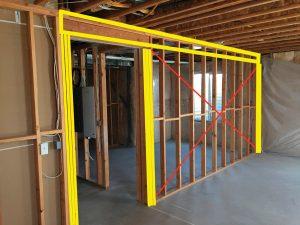 A few years ago, a neighbor of mine was very excited to tell me about their next Do-It-Yourself project they had planned. One portion of it involved removing a wall so they could combine their dining room and living room into a “grand room.” When I asked them if that wall was load-bearing or not, I was greeted with a blank look, and alarm bells started ringing. A load-bearing wall is one that transfers the load (both from the weight of the materials themselves and from outside forces, such as wind, rain, or snow) from the roof or an upper story down to the foundation. If you modify it, you have to make sure you provide an alternate path for the load to reach the earth and make sure that the alternate method is capable of carrying that load. If that is not done correctly, the results can be disastrous, ranging from a sagging ceiling to collapse. Conversely, you can modify a non-load-bearing wall (also called a partition wall) and only be concerned that whatever portion remains can support itself and doesn’t fall on you during the act of removal. So, what is an ambitious DIY homeowner to do?
A few years ago, a neighbor of mine was very excited to tell me about their next Do-It-Yourself project they had planned. One portion of it involved removing a wall so they could combine their dining room and living room into a “grand room.” When I asked them if that wall was load-bearing or not, I was greeted with a blank look, and alarm bells started ringing. A load-bearing wall is one that transfers the load (both from the weight of the materials themselves and from outside forces, such as wind, rain, or snow) from the roof or an upper story down to the foundation. If you modify it, you have to make sure you provide an alternate path for the load to reach the earth and make sure that the alternate method is capable of carrying that load. If that is not done correctly, the results can be disastrous, ranging from a sagging ceiling to collapse. Conversely, you can modify a non-load-bearing wall (also called a partition wall) and only be concerned that whatever portion remains can support itself and doesn’t fall on you during the act of removal. So, what is an ambitious DIY homeowner to do?
The first step is to determine if the wall is, or isn’t, part of the structural system of the home. The easiest way to do that is to review the drawings that were used to construct the building. Not surprisingly, few homeowners have those immediately on hand. However, if the home isn’t too old, you may be able to obtain them through a records request with the City of Tallahassee (go to www.talgov.com/growth/growth-recordrequest.aspx). By filling out a simple form, you can find out if the City has anything on file and have it e-mailed to you. You will need to identify the Parcel ID number of your property. I, personally, have no idea what my property’s ID number is, and I am sure I am not alone in that. Fortunately, with a quick search of the Leon County Property Appraisal’s website, you will be able to look up that information too by entering in your home’s address.
So, now what? How can you tell if the walls are part of the structural system? Assuming you don’t have an architect, structural engineer, or a contractor in the family whom you can ask, the drawings themselves may be able to give you the answer. The best place to start is, unsurprisingly, on the structural drawings. Typically, only the load-bearing elements are shown on the structural drawings. These can be walls, columns, braces, joists, or beams. If the wall in question shows up on the structural drawings, there is a very high chance that the wall is load-bearing. You may also find that although the wall itself doesn’t appear, there is a column concealed in the wall. The column, and the beams that connect to it, are definitely part of the structural system. One cautionary note here: buildings aren’t always built exactly as shown in the drawings. That can happen for many reasons. A field change may have occurred due to the type of soils discovered on site. Fluctuations in material prices may have prompted a change, or an undocumented modification was made after the initial construction was completed. If what you see in your home doesn’t seem to match what is shown on paper, err on the side of caution and look elsewhere for confirmation.
 If you can’t find any drawings, or they don’t match what you can see, there are still some other steps you can take. If your home has a crawl space, put on some old durable and protective clothes, grab a flashlight, and get ready to get dirty. Any walls within the crawl space that align with walls in the floor immediately above are most likely load-bearing. Note where you see columns and beams. If a wall above aligns with those, there is a strong chance that it is either load-bearing or conceals beams, columns, or braces that are load-bearing. Where you see floor joists, a wall above that is parallel to those joists is probably not load-bearing (although there are some circumstances where it still can be). If a wall above is perpendicular to the joists, it may or may not be part of the structural system. These same conditions would be visible in an unfinished basement too; you just wouldn’t have as much dirt to contend with.
If you can’t find any drawings, or they don’t match what you can see, there are still some other steps you can take. If your home has a crawl space, put on some old durable and protective clothes, grab a flashlight, and get ready to get dirty. Any walls within the crawl space that align with walls in the floor immediately above are most likely load-bearing. Note where you see columns and beams. If a wall above aligns with those, there is a strong chance that it is either load-bearing or conceals beams, columns, or braces that are load-bearing. Where you see floor joists, a wall above that is parallel to those joists is probably not load-bearing (although there are some circumstances where it still can be). If a wall above is perpendicular to the joists, it may or may not be part of the structural system. These same conditions would be visible in an unfinished basement too; you just wouldn’t have as much dirt to contend with.
Your attic can provide clues too. In modern construction, you will find hurricane clips and/or other metal tie downs where the rafters or trusses rest on top of a load-bearing wall—typically at every truss and rafter. Any wall where you see that type of connection should be assumed to be load-bearing. If the trusses cross over a wall without those, the wall is likely a partition or non-bearing wall. Be careful though. In older construction, the methods used to connect the roof system to the walls/beams below is not as obvious and can easily be concealed or overlooked.
In a slab-on-grade home, or a home with a finished basement, you can’t see most of the structure. Without removing sheetrock or other finishes, you are left with very few indicators. If you are not willing to remove some of the sheetrock to expose the structure behind, the clues that remain yield conclusions that are less and less certain. For example, any wall below a roof eave is either load-bearing or conceals some beams, braces, and/or columns. In residential construction, ducts are often run between joists. Structural members are more likely to be perpendicular to a long duct run. However, this is not a guarantee, as it is possible to run ducts perpendicular to joists if there is enough space between the underside of the joist and the ceiling or even through the joists if an open web system is used.
Removing any wall can be dangerous and should only be undertaken by someone who is familiar with the risks and knows how to take precautions to prevent injury and/or damage. Removing a load-bearing wall requires even more skill and knowledge. The structural system has to be maintained at all times. Usually, a temporary structural system called shoring must be installed prior to removing any structural member. The shoring provides temporary support until the final structural system is installed. You also need to be aware that electrical and plumbing lines will be in the wall. These will need to be safely disconnected and rerouted. The steps in this article should only be used to assess the relative costs of a remodel. Removing a partition wall will be less expensive than removing a load-bearing element.
If your remodeling plan includes modifying or relocating a wall, always err on the side of caution. Hire a professional, such as a structural engineer or an architect. One final note: in Florida, you need to pull a permit for any work that is greater than $1,000 or is structural. More information on when and how to pull a permit can be found online at www.talgov.com/growth/growth-buildinspfaqs.
In case you were wondering, my neighbor‘s wall was in fact load-bearing. Fortunately, they hadn’t yet started any demolition work yet. Enjoy your renovation project! ![]()
Karin Zawrotny, AIA, LEED BD+C
Karin is the current president of the AIA Tallahassee Chapter of the American Institute of Architects (AIA). The AIA represents the interests of more than 95,000 members worldwide, 3,600 of whom reside in Florida. Headquartered in Washington, DC, it has more than 200 Chapters.




